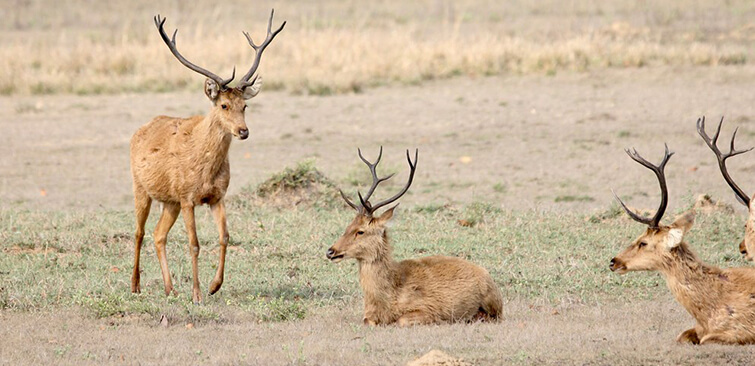





Copyright infringement not intended
Picture Courtesy: www.kanha-national-park.com
Context: The increase in the swamp deer population at Manas National Park & Tiger Reserve is a positive development for conservation efforts in the region.
Key Highlights
|
About Barasingha, also known as Swamp deer |
|
|
Name and Characteristics |
●Barasingha is commonly referred to as the "swamp deer" due to its preference for wetland habitats. ● The name "barasingha" is derived from the Hindi language, where "barah" means twelve, and "singha" means horn. This name highlights one of the most distinctive features of the species: their antlers, which typically have more than three tines (or points). This characteristic sets them apart from other Indian deer species. |
|
Physical Description |
●Barasingha is one of the largest deer species, with a shoulder height ranging from 44 to 46 inches (110 to 120 cm), with females being slightly smaller. They have a head-to-body length of nearly 6 feet (180 cm). ●The coat of the swamp deer is rather woolly and is yellowish-brown on the upper side, with paler colouring on the lower side. During the summer, their coat becomes bright rufous-brown. ●White spots run along the spine of their back. The throat, belly, inner thighs, and the area beneath the tail are white. ●Mature males (stags) often have impressive antlers with 10 to 14 tines, though some exceptionally large individuals may have up to 20 tines. ●Female barasingha are generally paler in colour than males. ●Young barasingha are born with spots on their coat. |
|
Distribution and Habitat |
●Historically, swamp deer were found in various regions, including parts of northern and central India, southwestern Nepal, Pakistan, and Bangladesh. ●Barasingha prefers flat or undulating grasslands, floodplains, marshes, and areas on the outskirts of forests. At times, they are also found in open forested areas. ●Distribution in India: ○They are found in six localities in Uttar Pradesh. ○In Kanha National Park in Madhya Pradesh. ○Near Dhamtari in Chhattisgarh. ○In Kaziranga and Manas National Parks in Assam. |
|
Subspecies |
There are three recognized subspecies of barasingha: ●Western swamp deer: Most abundant, adapted to flooded grassland habitats of the Indo-Gangetic plain. ●Southern swamp deer: Adapted to hard ground in open sal forests. ●Eastern swamp deer: Found in Assam, primarily in Kaziranga National Park. |
|
Ecology and Behavior |
●Barasingha are primarily grazers, feeding on grasses and aquatic plants such as Saccharum, Imperata cylindrica, and Oryza rufipogon. ●They feed throughout the day, with peak feeding times during the mornings and late afternoons to evenings. ●Breeding season occurs from September to April, with births typically happening in August to November. They give birth to single calves. ●Compared to some other deer species, they have fewer sentries and spend most of their time grazing. ●Swamp deer are known for their strong social structure, living in groups or herds. |
|
Threats |
●Swamp deer populations outside of protected areas and seasonally migrating populations are threatened by poaching for antlers and meat. ●Habitat loss due to the conversion of wetlands for agriculture has reduced suitable habitats to small and isolated fragments. ●Habitat in protected areas is also threatened by changes in river dynamics, reduced water flow during summer, siltation, and local activities such as grass cutting and illegal farming. |
|
Conservation |
●It is listed under Appendix I of CITES, which prohibits international trade in this species unless under exceptional circumstances. ●The swamp deer is classified as "Vulnerable" on the IUCN Red List, meaning it faces a high risk of extinction in the wild if conservation measures are not taken. ●In India, it is listed under Schedule I of the Wildlife Protection Act, 1972, offering the highest level of legal protection. ●Conservation efforts include protecting and restoring their habitats, combating poaching, and conducting translocation attempts to establish new populations. |
|
Additional facts |
●Swamp deer are the largest deer species in India. ●They are excellent swimmers and can easily cross rivers and swamps. ●They are very shy animals and are difficult to see in the wild. ●They play an important role in the ecosystem by helping to control the growth of vegetation. |
Conclusion
Must Read Articles:
Eastern swamp deer: https://www.iasgyan.in/daily-current-affairs/eastern-swamp-deer
|
PRACTICE QUESTION Q. Consider the following statements in the context of the Barasingha, commonly referred to as the "swamp deer": 1. They are the largest deer species in India. 2. They are classified as "Vulnerable" on the IUCN Red List. 3. They are known for their strong social structure, often living in groups or herds. 4. They are known for their strong swimming ability. How many of the above statement is/are correct? A) Only one B) Only two C) Only three D) All four Answer: D Explanation: 1.They are the largest deer species in India. - This statement is correct. Barasingha is indeed the largest deer species in India. 2.They are classified as "Vulnerable" on the IUCN Red List. - This statement is correct. Barasingha is classified as "Vulnerable" on the IUCN Red List, indicating a high risk of extinction in the wild. 3.They are known for their strong social structure, often living in groups or herds. - This statement is correct. Barasingha are known for their strong social structure and often live in groups or herds. 4.They are known for their strong swimming ability. - This statement is correct. Barasingha are known for their strong swimming ability and can easily cross rivers and swamps. Therefore, all four statements are correct. The correct answer is (D) All four. |










© 2025 iasgyan. All right reserved